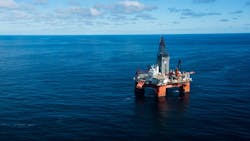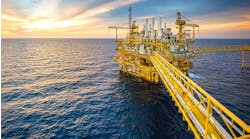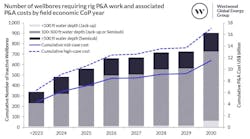Offshore staff
STAVANGER, Norway – Equinor and its partners DNO Norge, Petoro, and Wellesley Petroleum have discovered gas and oil in the Røver Nord prospect in the Norwegian North Sea.
The semisubmersible West Hercules drilled exploration well 31/1-2 S and appraisal well 31/1-2 A in production license 923, 10 km (6 mi) northwest of the Troll field, 18 km (11 mi) southwest of the Fram field, and 130 km (81 mi) northwest of Bergen. Water depth is 349 m (1,145 ft).
Recoverable resources are estimated at between 44 and 69 MMboe.
The primary exploration target for exploration well 31/1-2 S was to prove petroleum in the Brent group from the Middle Jurassic period and in the Cook formation from the Early Jurassic period. The purpose of 31/1-2 A was to delineate the discovery made in the Brent Group in well 31/1-2 S.
Both wells proved hydrocarbons in two intervals in the Brent Group. Well 31/1-2 S encountered an about 145-m (476-ft) gas column in the Brent Group (Etive and Oseberg formations) and a 24-m (79-ft) oil column where the oil/water contact was not encountered. A total of 50 m (164 ft) of effective sandstone reservoir with good reservoir quality was found in this interval. In addition, 6 m (20 ft) of oil-bearing sandstone with moderate to poor reservoir quality was struck in the upper part of the Dunlin Group.
Appraisal well 31/1-2 A struck sandstones with good to moderate reservoir quality in the Etive formation and upper part of the Oseberg formation. The lower part of the Oseberg formation contained sandstone with moderate to poor reservoir quality. An estimated total of 41 m (135 ft) of effective sandstone reservoir was found in the two formations. The well proved 12 m (39 ft) of oil in the Etive formation, where the oil/water contact was not encountered, and a 17-m (56-ft) oil column in the Oseberg formation.
The Cook formation proved to be water-filled in both wells, but with moderate to good reservoir quality. The wells were not formation tested, but extensive data acquisition and sampling took place.
According to Equinor, the licensees consider the discovery commercial, and will explore development solutions toward existing infrastructure.
Well 31/1-2 S was drilled to a vertical depth of 3,439.5 m (11,284 ft) below sea level and a measured depth of 3,555 m (11,663 ft). The well was terminated in the Amundsen formation from the Early Jurassic period. Well 31/1-2 A was drilled to a vertical depth of 3,452 m (11,325 ft) below sea level and a measured depth of 3,876 m (12,717 ft). The well was terminated in the Cook formation.
Both wells have been permanently P&A’d.
These were the first two exploration wells in production license 923, which was awarded through the APA 2017 licensing round.
The West Hercules will next drill exploration well 31/2-22 S in production license 090 in the northern North Sea.
02/05/2021




